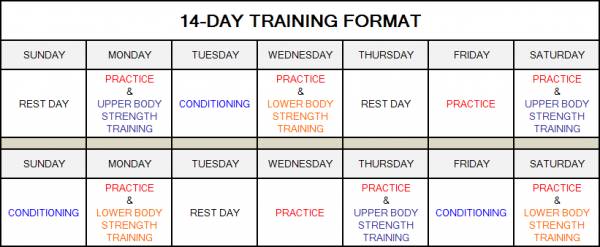I know there are seven days in a week and all should be used when designing a sensible training plan. By suggesting all should be used, I mean some are work days and some are recovery days, depending on the training activities you are doing. If your training activity is only conditioning (running) or only strength training (lifting), then that’s all you have plan for.
If you add strength training to your conditioning or conditioning to your strength training, then more strategic planning is necessary:
- How many strength training and conditioning sessions per week?
- Total body strength training sessions or a split routine?
- Separate conditioning and strength training days?
- Concurrent conditioning and strength training days?
- Conditioning before or after strength training?
Getting in even deeper, if you’re an athlete you’ll need to add sport-skill practice:
- How many practice, strength training, and conditioning sessions per week?
- Total body strength training sessions or a split routine?
- Separate practice, conditioning, and strength training days?
- Concurrent practice and strength training days?
- Concurrent practice and conditioning days?
- Concurrent practice, conditioning, and strength training days?
- Practice before or after strength training?
- Conditioning before or after practice?
- Strength train before or after conditioning?
And don’t forget the often neglected recovery factor:
- How are you going to recover from all of these activity and exercises stresses?
- Can you even schedule a full day of complete rest?
- If you practice and condition on one day, will you be recovered enough to strength train the following day?
- Likewise, if you have a demanding strength training session on one day, will you be recovered enough to practice well enough the next day?
- What will you schedule the day following a demanding practice, strength training, and conditioning day?
It can be quite a challenge to get it all in, knowing all components are important and all should be worked hard. And you’re doing this with one body. It’s not like you have a fresh new body for each day of the week like you have clean clothes. Your body needs time to recover. Beating it down day after day will only lead to injury, fatigue, and poor results. Time must be allowed for gains to occur from previous stresses.
As you can see, it’s hard enough with a full seven-day week as the template. Try doing all of it over a five-day period like most college athletes do. In my 23 years in college strength and conditioning I dealt with the five-day cram-it-all-in approach. It was quite challenging.
Here is the solution. Don’t look at training only over seven days. Look at it over a continuum of fourteen to 21 days. I know this may be impractical for some due to their weekly work and family schedules; however, if you’re able to do it, it can facilitate better results.
The hard-to-recover-from seven-day plan may look like these two formats:

Over two weeks you would have:
- Ten practice sessions
- Six total body strength training sessions
- Six conditioning sessions
- Ten multiple component training days
- Six consecutive work days with only one complete rest day each week

This format would offer:
- Eight practice sessions
- Four upper body strength training sessions
- Four lower body strength training sessions
- Eight conditioning sessions
- Eight multiple component training days
- Six consecutive work days with only one complete rest day each week
Spreading the work over fourteen days allows for more recovery, fewer multiple component training days, and quality training sessions. Here’s what a fourteen-day format looks like:

- Eight practice sessions
- Two practice-only days to allow for quality work
- A complete rest day precedes the two practice-only days to allow for quality work
- Three upper body strength training sessions
- Three lower body strength training sessions
- Three days of conditioning-only to allow for quality work
- Only six multiple component training days
- Only three or four consecutive work days followed by a complete rest day
Similarly, planning the training over 21 days can offer even more important recovery days and quality training sessions. Take a look at the 21-day format:

- Every fourth day is a rest day
- A complete rest day precedes practices days to allow for quality work
- Three practice-only days to allow for quality work
- Alternating total body and split routine strength training for variety
- Each body part is strength trained five times to allow for recovery
- Only nine multiple component training days
- An optional rest or work day at the end of the cycle
Many training plans work if you allow for your body to recover and adapt. The traditional seven-day format can hinder proper recovery, especially if you have multiple training components to schedule. In that case plan your training beyond the typical one-week cycle and view it as a continuum of days over a longer cycle, such as fourteen or 21 days. Doing so may help you achieve better results while avoiding injuries and overtraining.
Photo courtesy of Shutterstock.






